Sustainable Systems in Geography
VerifiedAdded on 2023/03/31
|21
|2824
|122
AI Summary
This report discusses the concept of sustainability in systems, focusing on the impact on the environment. It evaluates the life cycle of wooden and steel dining tables and identifies the best sustainable alternative. The report also provides a cost benefit analysis of energy efficiency in light bulbs.
Contribute Materials
Your contribution can guide someone’s learning journey. Share your
documents today.
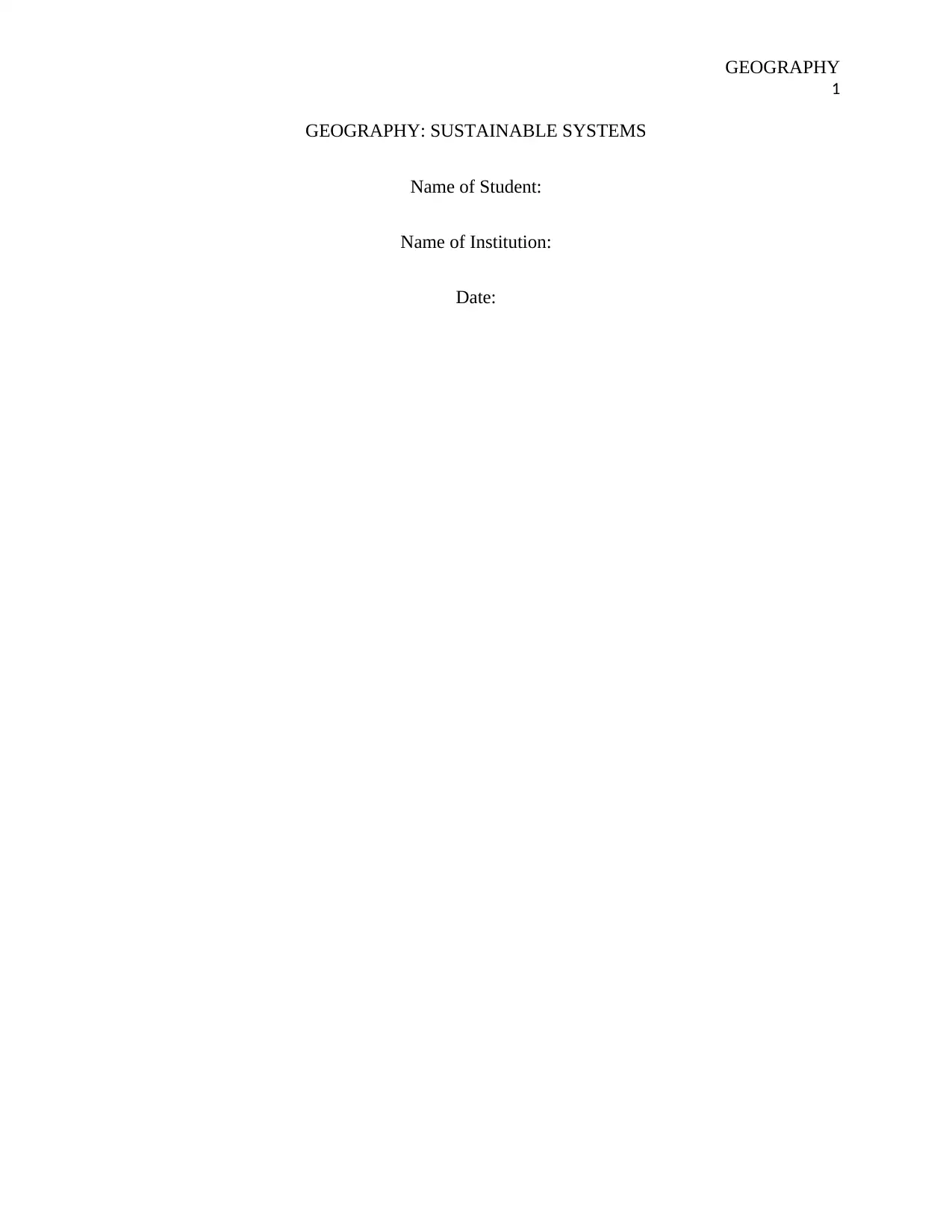
GEOGRAPHY
1
GEOGRAPHY: SUSTAINABLE SYSTEMS
Name of Student:
Name of Institution:
Date:
1
GEOGRAPHY: SUSTAINABLE SYSTEMS
Name of Student:
Name of Institution:
Date:
Secure Best Marks with AI Grader
Need help grading? Try our AI Grader for instant feedback on your assignments.
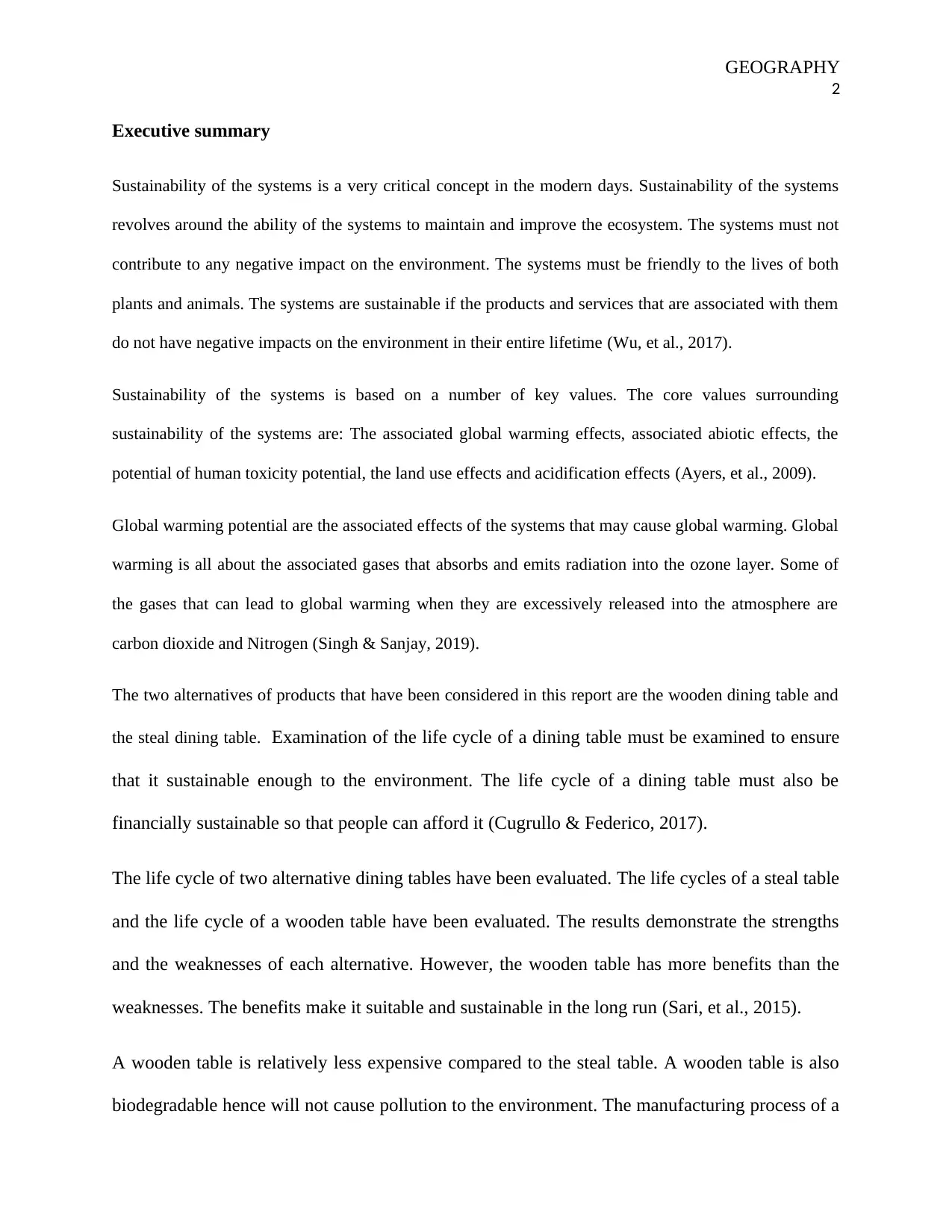
GEOGRAPHY
2
Executive summary
Sustainability of the systems is a very critical concept in the modern days. Sustainability of the systems
revolves around the ability of the systems to maintain and improve the ecosystem. The systems must not
contribute to any negative impact on the environment. The systems must be friendly to the lives of both
plants and animals. The systems are sustainable if the products and services that are associated with them
do not have negative impacts on the environment in their entire lifetime (Wu, et al., 2017).
Sustainability of the systems is based on a number of key values. The core values surrounding
sustainability of the systems are: The associated global warming effects, associated abiotic effects, the
potential of human toxicity potential, the land use effects and acidification effects (Ayers, et al., 2009).
Global warming potential are the associated effects of the systems that may cause global warming. Global
warming is all about the associated gases that absorbs and emits radiation into the ozone layer. Some of
the gases that can lead to global warming when they are excessively released into the atmosphere are
carbon dioxide and Nitrogen (Singh & Sanjay, 2019).
The two alternatives of products that have been considered in this report are the wooden dining table and
the steal dining table. Examination of the life cycle of a dining table must be examined to ensure
that it sustainable enough to the environment. The life cycle of a dining table must also be
financially sustainable so that people can afford it (Cugrullo & Federico, 2017).
The life cycle of two alternative dining tables have been evaluated. The life cycles of a steal table
and the life cycle of a wooden table have been evaluated. The results demonstrate the strengths
and the weaknesses of each alternative. However, the wooden table has more benefits than the
weaknesses. The benefits make it suitable and sustainable in the long run (Sari, et al., 2015).
A wooden table is relatively less expensive compared to the steal table. A wooden table is also
biodegradable hence will not cause pollution to the environment. The manufacturing process of a
2
Executive summary
Sustainability of the systems is a very critical concept in the modern days. Sustainability of the systems
revolves around the ability of the systems to maintain and improve the ecosystem. The systems must not
contribute to any negative impact on the environment. The systems must be friendly to the lives of both
plants and animals. The systems are sustainable if the products and services that are associated with them
do not have negative impacts on the environment in their entire lifetime (Wu, et al., 2017).
Sustainability of the systems is based on a number of key values. The core values surrounding
sustainability of the systems are: The associated global warming effects, associated abiotic effects, the
potential of human toxicity potential, the land use effects and acidification effects (Ayers, et al., 2009).
Global warming potential are the associated effects of the systems that may cause global warming. Global
warming is all about the associated gases that absorbs and emits radiation into the ozone layer. Some of
the gases that can lead to global warming when they are excessively released into the atmosphere are
carbon dioxide and Nitrogen (Singh & Sanjay, 2019).
The two alternatives of products that have been considered in this report are the wooden dining table and
the steal dining table. Examination of the life cycle of a dining table must be examined to ensure
that it sustainable enough to the environment. The life cycle of a dining table must also be
financially sustainable so that people can afford it (Cugrullo & Federico, 2017).
The life cycle of two alternative dining tables have been evaluated. The life cycles of a steal table
and the life cycle of a wooden table have been evaluated. The results demonstrate the strengths
and the weaknesses of each alternative. However, the wooden table has more benefits than the
weaknesses. The benefits make it suitable and sustainable in the long run (Sari, et al., 2015).
A wooden table is relatively less expensive compared to the steal table. A wooden table is also
biodegradable hence will not cause pollution to the environment. The manufacturing process of a
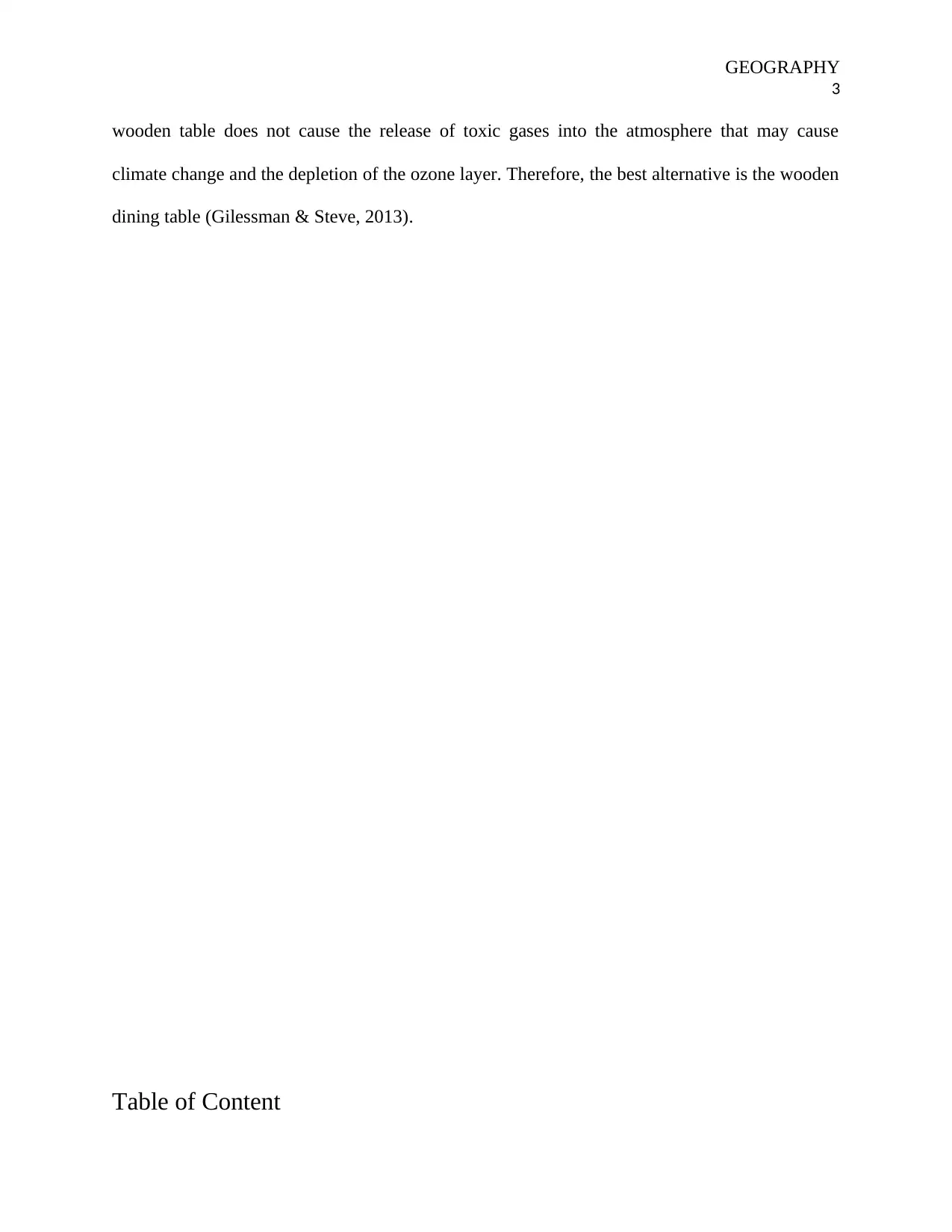
GEOGRAPHY
3
wooden table does not cause the release of toxic gases into the atmosphere that may cause
climate change and the depletion of the ozone layer. Therefore, the best alternative is the wooden
dining table (Gilessman & Steve, 2013).
Table of Content
3
wooden table does not cause the release of toxic gases into the atmosphere that may cause
climate change and the depletion of the ozone layer. Therefore, the best alternative is the wooden
dining table (Gilessman & Steve, 2013).
Table of Content

GEOGRAPHY
4
Introduction.................................................................................................................................................5
Services Wanted..........................................................................................................................................6
The Two alternatives...................................................................................................................................6
Reason for Choosing the problem...............................................................................................................6
Functional Units..........................................................................................................................................7
The Recommended Procedure for conducting a Life Cycle Assessment.....................................................7
Analysis of Each Alternative/Life Cycle Assessment..................................................................................9
Improved Option.......................................................................................................................................14
Best Alternative.........................................................................................................................................14
Conclusion.................................................................................................................................................14
References.................................................................................................................................................15
ENERGY EFFICIENCY...........................................................................................................................16
Executive Summary...................................................................................................................................16
Introduction...............................................................................................................................................17
Cost benefit analysis of a Water Dispenser...............................................................................................17
Conclusion.................................................................................................................................................19
References.................................................................................................................................................19
References.................................................................................................................................................20
Introduction
Sustainability of the systems is a very critical concept in the modern days. Sustainability of the systems
revolves around the ability of the systems to maintain and improve the ecosystem. The systems must not
4
Introduction.................................................................................................................................................5
Services Wanted..........................................................................................................................................6
The Two alternatives...................................................................................................................................6
Reason for Choosing the problem...............................................................................................................6
Functional Units..........................................................................................................................................7
The Recommended Procedure for conducting a Life Cycle Assessment.....................................................7
Analysis of Each Alternative/Life Cycle Assessment..................................................................................9
Improved Option.......................................................................................................................................14
Best Alternative.........................................................................................................................................14
Conclusion.................................................................................................................................................14
References.................................................................................................................................................15
ENERGY EFFICIENCY...........................................................................................................................16
Executive Summary...................................................................................................................................16
Introduction...............................................................................................................................................17
Cost benefit analysis of a Water Dispenser...............................................................................................17
Conclusion.................................................................................................................................................19
References.................................................................................................................................................19
References.................................................................................................................................................20
Introduction
Sustainability of the systems is a very critical concept in the modern days. Sustainability of the systems
revolves around the ability of the systems to maintain and improve the ecosystem. The systems must not
Secure Best Marks with AI Grader
Need help grading? Try our AI Grader for instant feedback on your assignments.
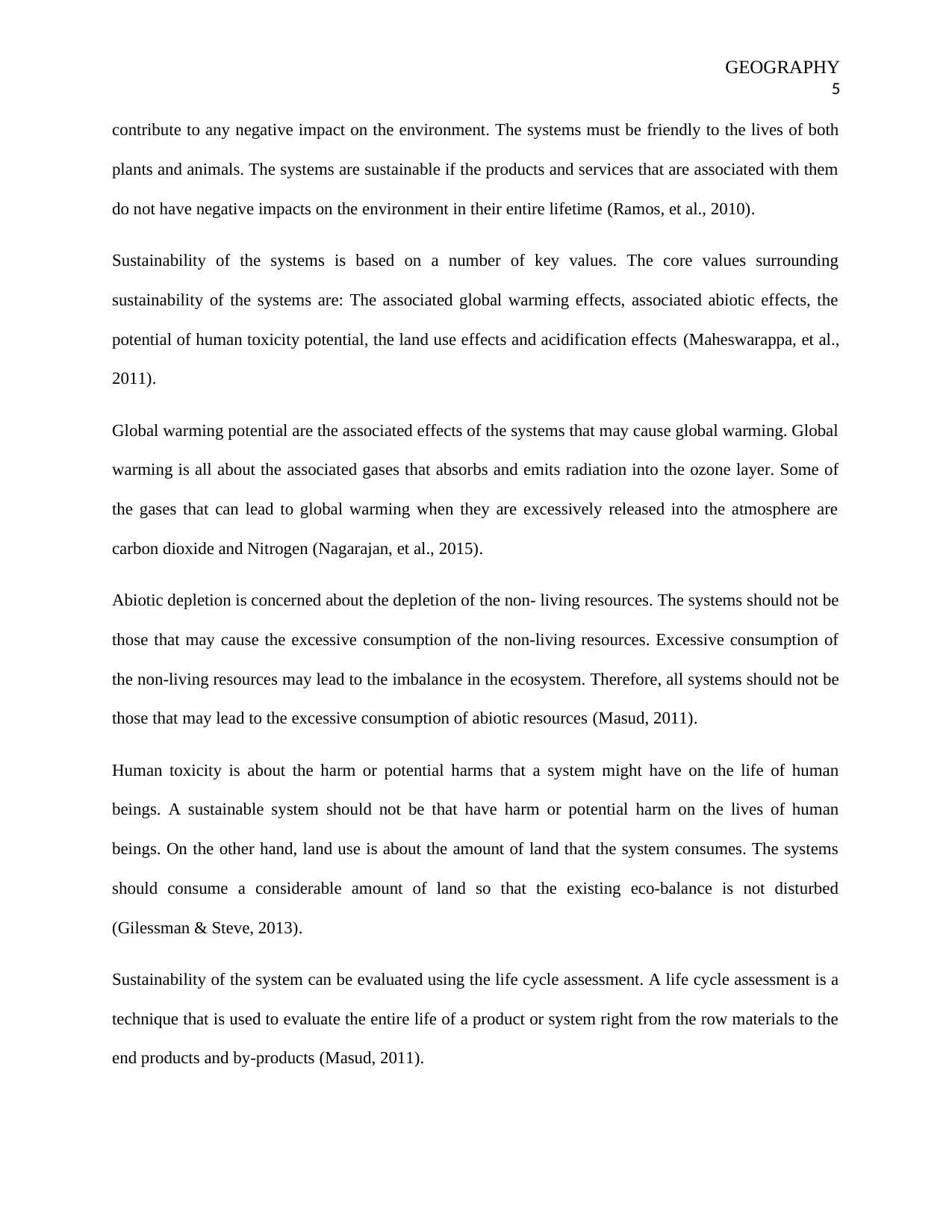
GEOGRAPHY
5
contribute to any negative impact on the environment. The systems must be friendly to the lives of both
plants and animals. The systems are sustainable if the products and services that are associated with them
do not have negative impacts on the environment in their entire lifetime (Ramos, et al., 2010).
Sustainability of the systems is based on a number of key values. The core values surrounding
sustainability of the systems are: The associated global warming effects, associated abiotic effects, the
potential of human toxicity potential, the land use effects and acidification effects (Maheswarappa, et al.,
2011).
Global warming potential are the associated effects of the systems that may cause global warming. Global
warming is all about the associated gases that absorbs and emits radiation into the ozone layer. Some of
the gases that can lead to global warming when they are excessively released into the atmosphere are
carbon dioxide and Nitrogen (Nagarajan, et al., 2015).
Abiotic depletion is concerned about the depletion of the non- living resources. The systems should not be
those that may cause the excessive consumption of the non-living resources. Excessive consumption of
the non-living resources may lead to the imbalance in the ecosystem. Therefore, all systems should not be
those that may lead to the excessive consumption of abiotic resources (Masud, 2011).
Human toxicity is about the harm or potential harms that a system might have on the life of human
beings. A sustainable system should not be that have harm or potential harm on the lives of human
beings. On the other hand, land use is about the amount of land that the system consumes. The systems
should consume a considerable amount of land so that the existing eco-balance is not disturbed
(Gilessman & Steve, 2013).
Sustainability of the system can be evaluated using the life cycle assessment. A life cycle assessment is a
technique that is used to evaluate the entire life of a product or system right from the row materials to the
end products and by-products (Masud, 2011).
5
contribute to any negative impact on the environment. The systems must be friendly to the lives of both
plants and animals. The systems are sustainable if the products and services that are associated with them
do not have negative impacts on the environment in their entire lifetime (Ramos, et al., 2010).
Sustainability of the systems is based on a number of key values. The core values surrounding
sustainability of the systems are: The associated global warming effects, associated abiotic effects, the
potential of human toxicity potential, the land use effects and acidification effects (Maheswarappa, et al.,
2011).
Global warming potential are the associated effects of the systems that may cause global warming. Global
warming is all about the associated gases that absorbs and emits radiation into the ozone layer. Some of
the gases that can lead to global warming when they are excessively released into the atmosphere are
carbon dioxide and Nitrogen (Nagarajan, et al., 2015).
Abiotic depletion is concerned about the depletion of the non- living resources. The systems should not be
those that may cause the excessive consumption of the non-living resources. Excessive consumption of
the non-living resources may lead to the imbalance in the ecosystem. Therefore, all systems should not be
those that may lead to the excessive consumption of abiotic resources (Masud, 2011).
Human toxicity is about the harm or potential harms that a system might have on the life of human
beings. A sustainable system should not be that have harm or potential harm on the lives of human
beings. On the other hand, land use is about the amount of land that the system consumes. The systems
should consume a considerable amount of land so that the existing eco-balance is not disturbed
(Gilessman & Steve, 2013).
Sustainability of the system can be evaluated using the life cycle assessment. A life cycle assessment is a
technique that is used to evaluate the entire life of a product or system right from the row materials to the
end products and by-products (Masud, 2011).
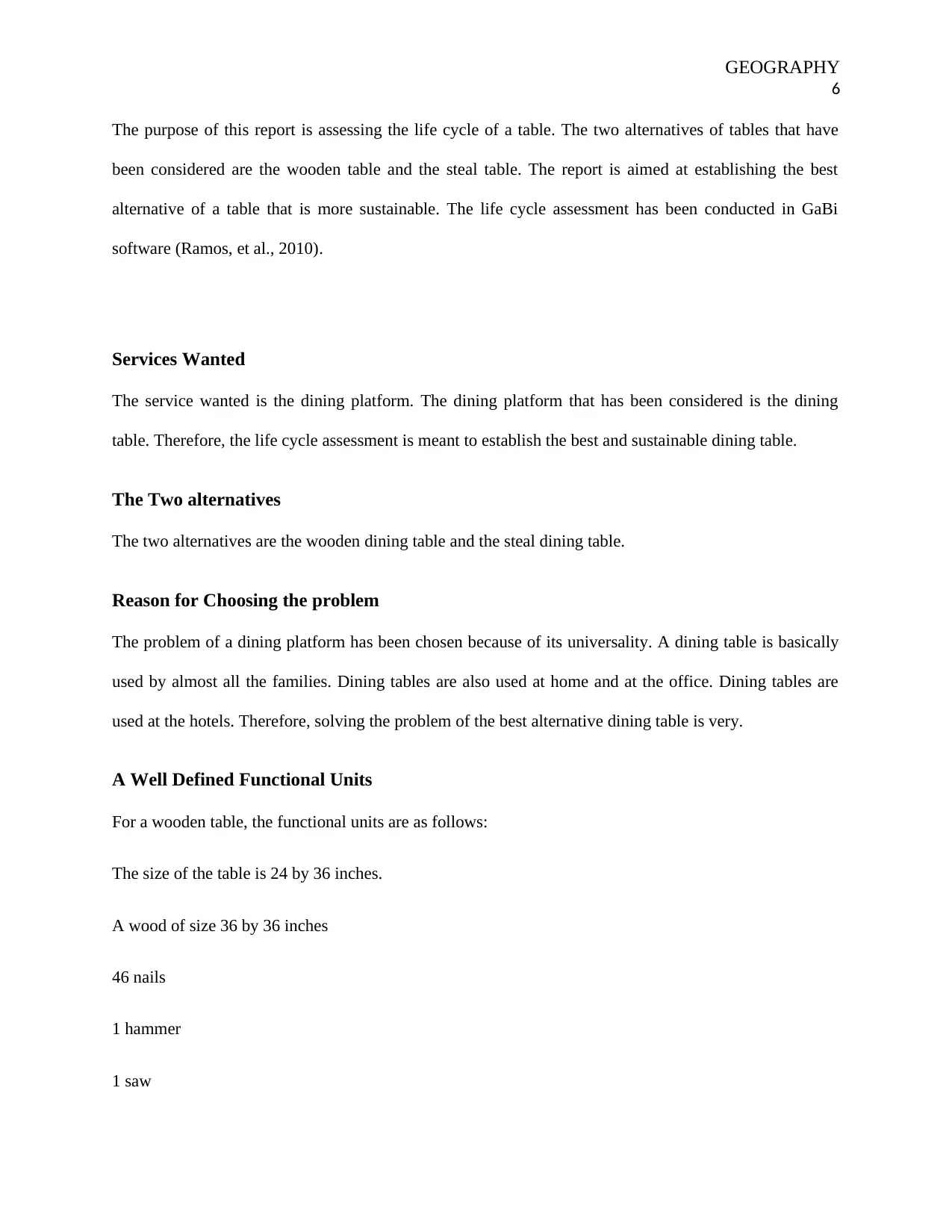
GEOGRAPHY
6
The purpose of this report is assessing the life cycle of a table. The two alternatives of tables that have
been considered are the wooden table and the steal table. The report is aimed at establishing the best
alternative of a table that is more sustainable. The life cycle assessment has been conducted in GaBi
software (Ramos, et al., 2010).
Services Wanted
The service wanted is the dining platform. The dining platform that has been considered is the dining
table. Therefore, the life cycle assessment is meant to establish the best and sustainable dining table.
The Two alternatives
The two alternatives are the wooden dining table and the steal dining table.
Reason for Choosing the problem
The problem of a dining platform has been chosen because of its universality. A dining table is basically
used by almost all the families. Dining tables are also used at home and at the office. Dining tables are
used at the hotels. Therefore, solving the problem of the best alternative dining table is very.
A Well Defined Functional Units
For a wooden table, the functional units are as follows:
The size of the table is 24 by 36 inches.
A wood of size 36 by 36 inches
46 nails
1 hammer
1 saw
6
The purpose of this report is assessing the life cycle of a table. The two alternatives of tables that have
been considered are the wooden table and the steal table. The report is aimed at establishing the best
alternative of a table that is more sustainable. The life cycle assessment has been conducted in GaBi
software (Ramos, et al., 2010).
Services Wanted
The service wanted is the dining platform. The dining platform that has been considered is the dining
table. Therefore, the life cycle assessment is meant to establish the best and sustainable dining table.
The Two alternatives
The two alternatives are the wooden dining table and the steal dining table.
Reason for Choosing the problem
The problem of a dining platform has been chosen because of its universality. A dining table is basically
used by almost all the families. Dining tables are also used at home and at the office. Dining tables are
used at the hotels. Therefore, solving the problem of the best alternative dining table is very.
A Well Defined Functional Units
For a wooden table, the functional units are as follows:
The size of the table is 24 by 36 inches.
A wood of size 36 by 36 inches
46 nails
1 hammer
1 saw
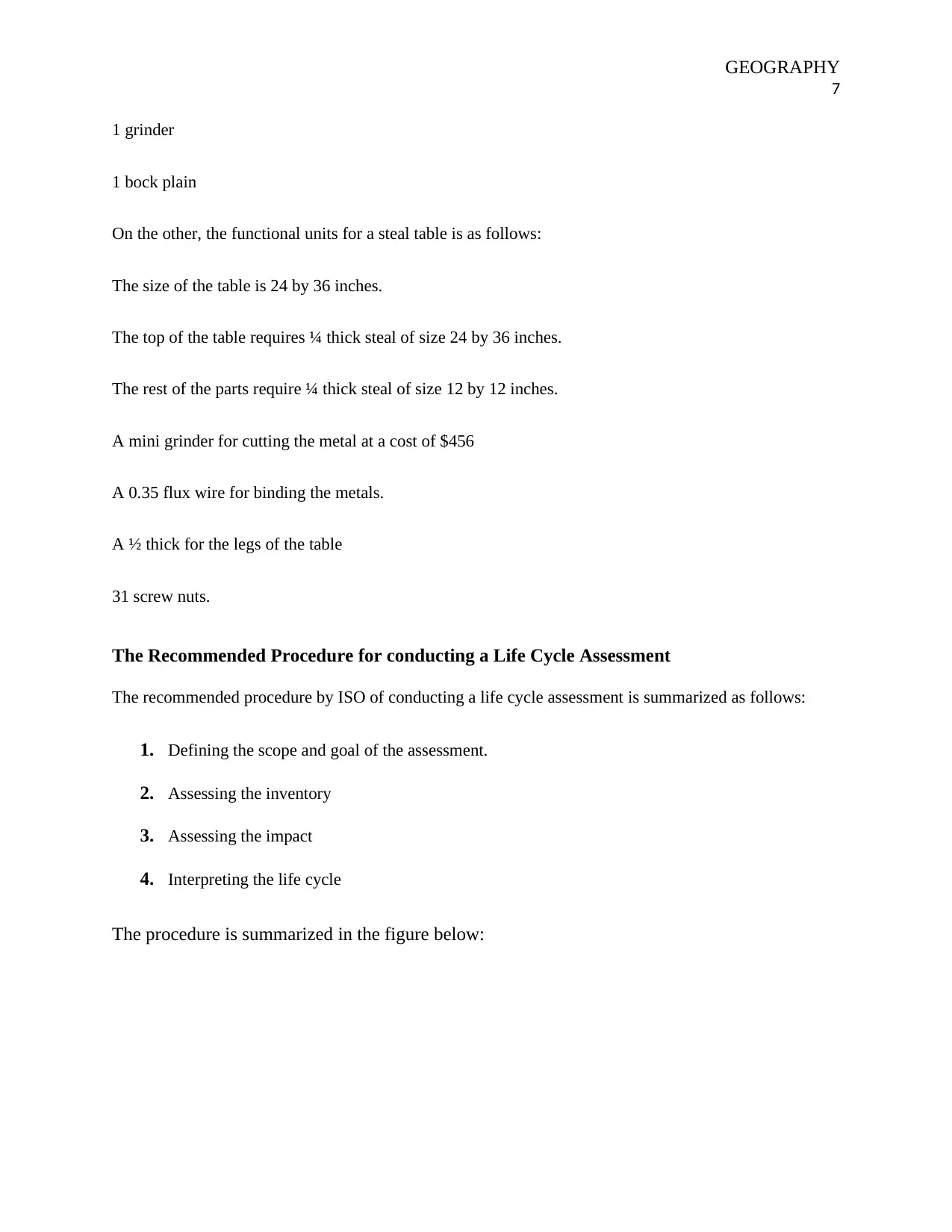
GEOGRAPHY
7
1 grinder
1 bock plain
On the other, the functional units for a steal table is as follows:
The size of the table is 24 by 36 inches.
The top of the table requires ¼ thick steal of size 24 by 36 inches.
The rest of the parts require ¼ thick steal of size 12 by 12 inches.
A mini grinder for cutting the metal at a cost of $456
A 0.35 flux wire for binding the metals.
A ½ thick for the legs of the table
31 screw nuts.
The Recommended Procedure for conducting a Life Cycle Assessment
The recommended procedure by ISO of conducting a life cycle assessment is summarized as follows:
1. Defining the scope and goal of the assessment.
2. Assessing the inventory
3. Assessing the impact
4. Interpreting the life cycle
The procedure is summarized in the figure below:
7
1 grinder
1 bock plain
On the other, the functional units for a steal table is as follows:
The size of the table is 24 by 36 inches.
The top of the table requires ¼ thick steal of size 24 by 36 inches.
The rest of the parts require ¼ thick steal of size 12 by 12 inches.
A mini grinder for cutting the metal at a cost of $456
A 0.35 flux wire for binding the metals.
A ½ thick for the legs of the table
31 screw nuts.
The Recommended Procedure for conducting a Life Cycle Assessment
The recommended procedure by ISO of conducting a life cycle assessment is summarized as follows:
1. Defining the scope and goal of the assessment.
2. Assessing the inventory
3. Assessing the impact
4. Interpreting the life cycle
The procedure is summarized in the figure below:
Paraphrase This Document
Need a fresh take? Get an instant paraphrase of this document with our AI Paraphraser
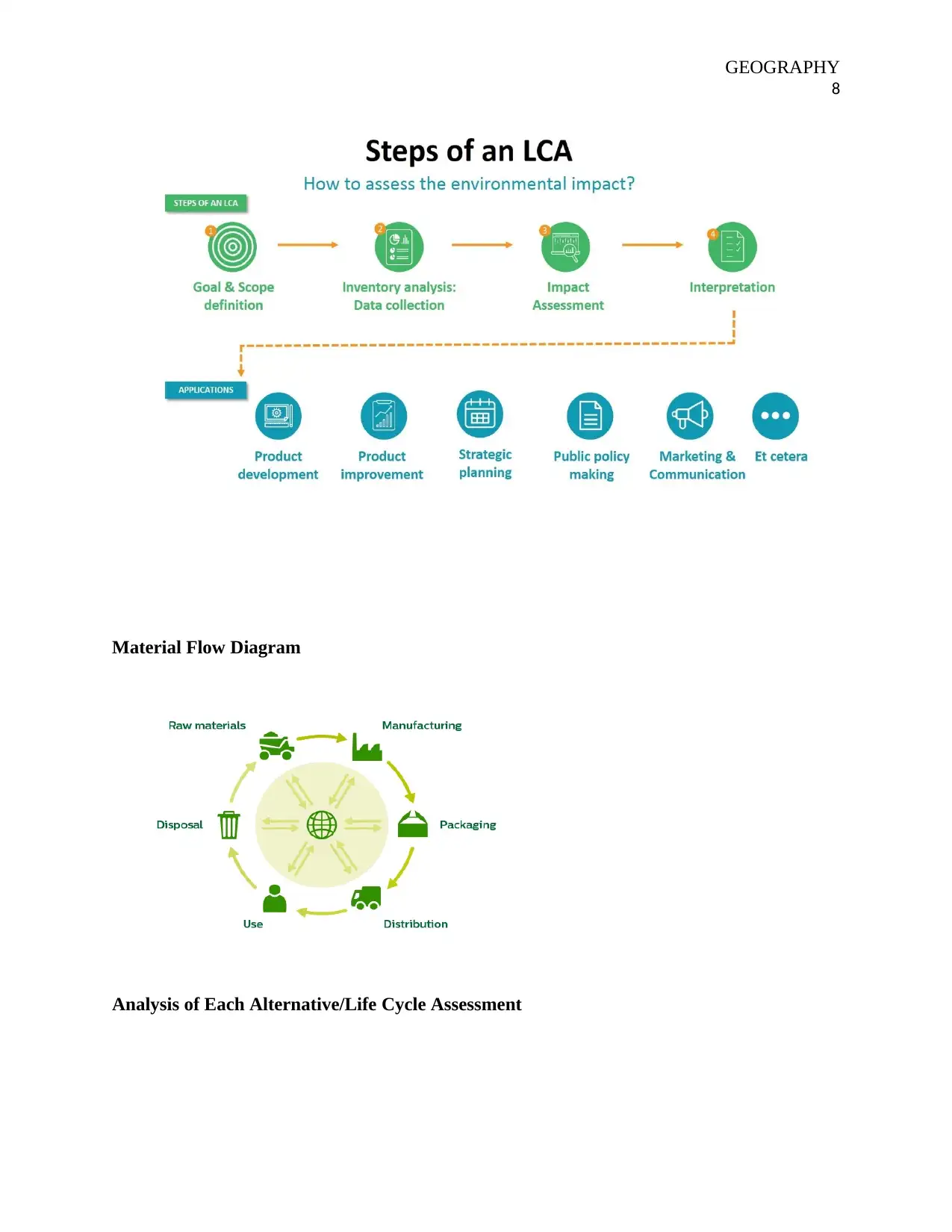
GEOGRAPHY
8
Material Flow Diagram
Analysis of Each Alternative/Life Cycle Assessment
8
Material Flow Diagram
Analysis of Each Alternative/Life Cycle Assessment
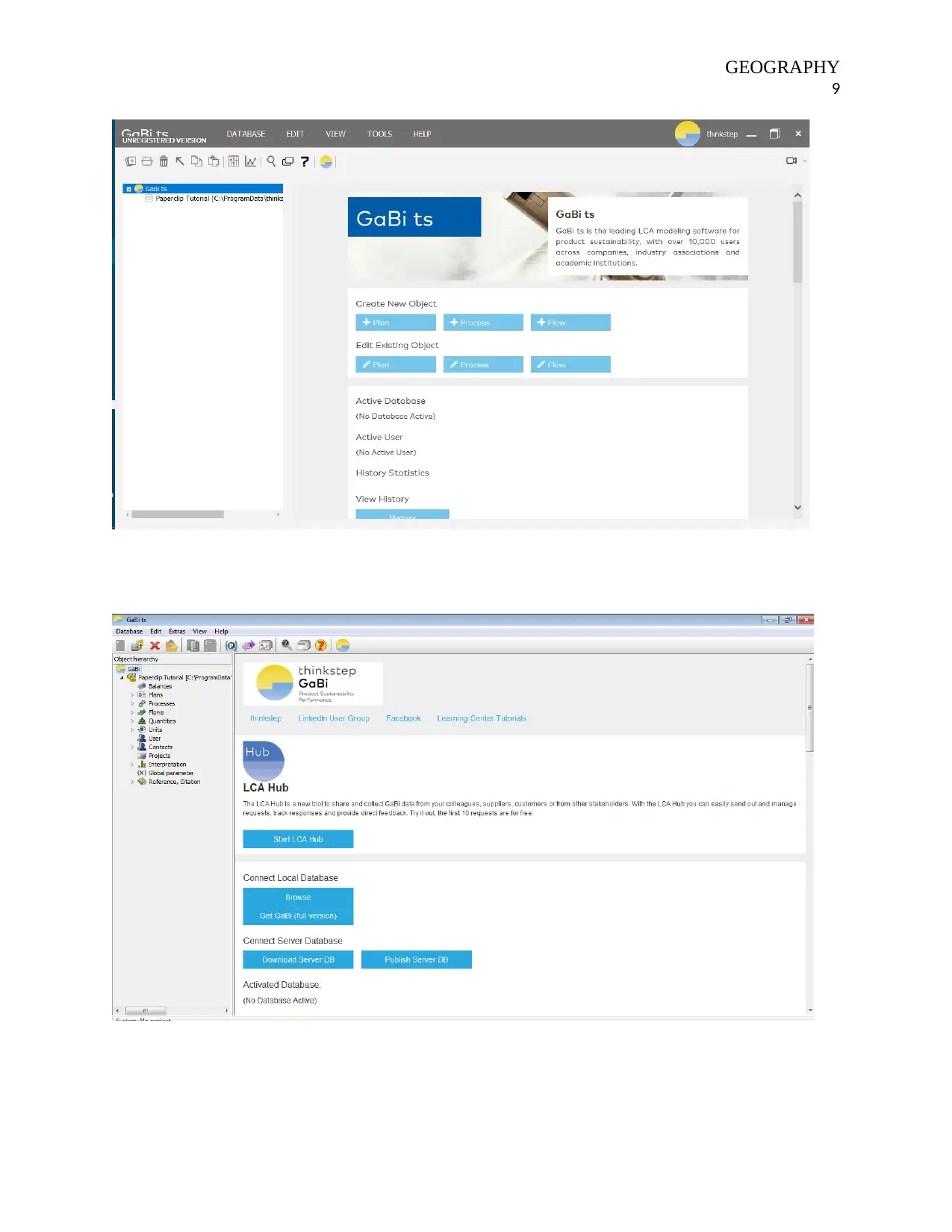
GEOGRAPHY
9
9
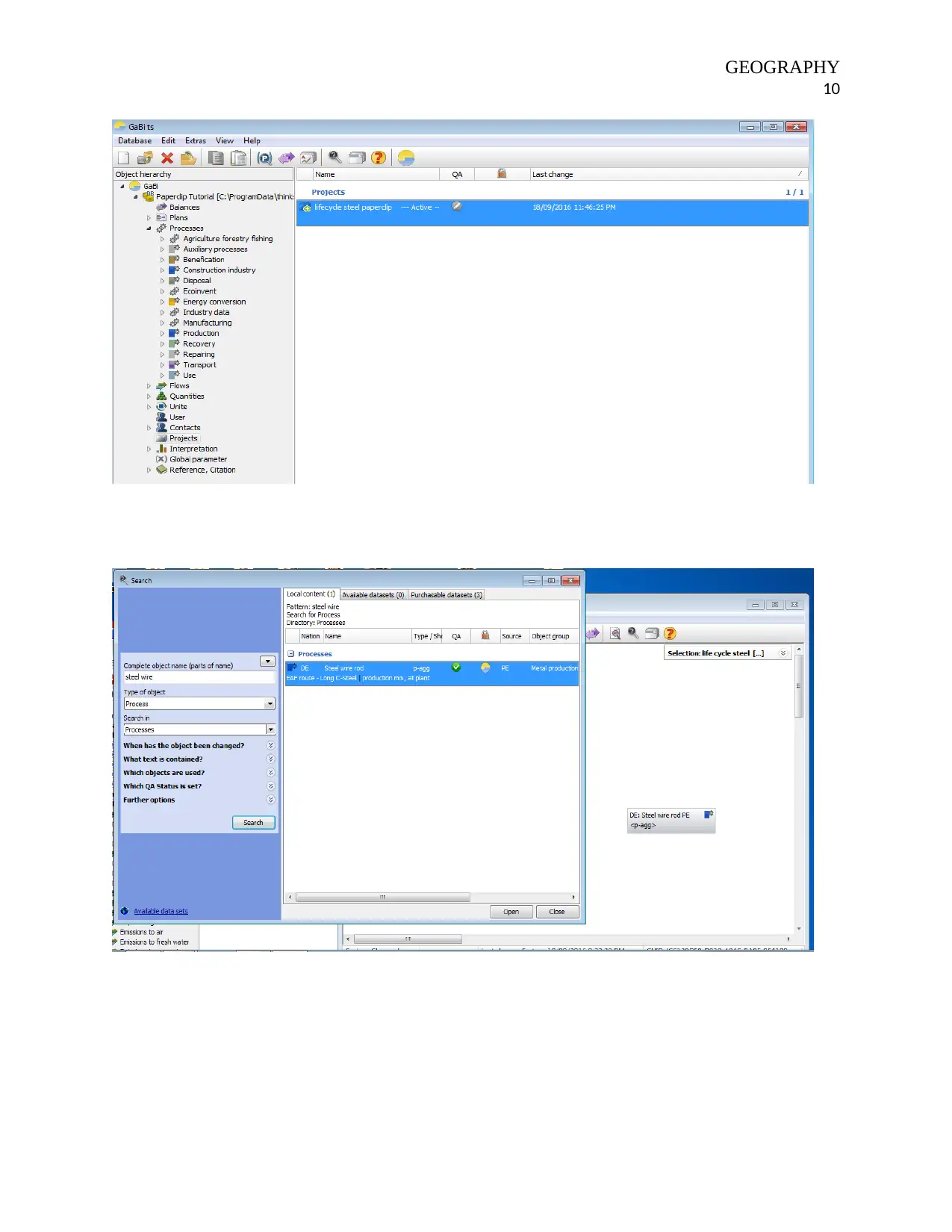
GEOGRAPHY
10
10
Secure Best Marks with AI Grader
Need help grading? Try our AI Grader for instant feedback on your assignments.
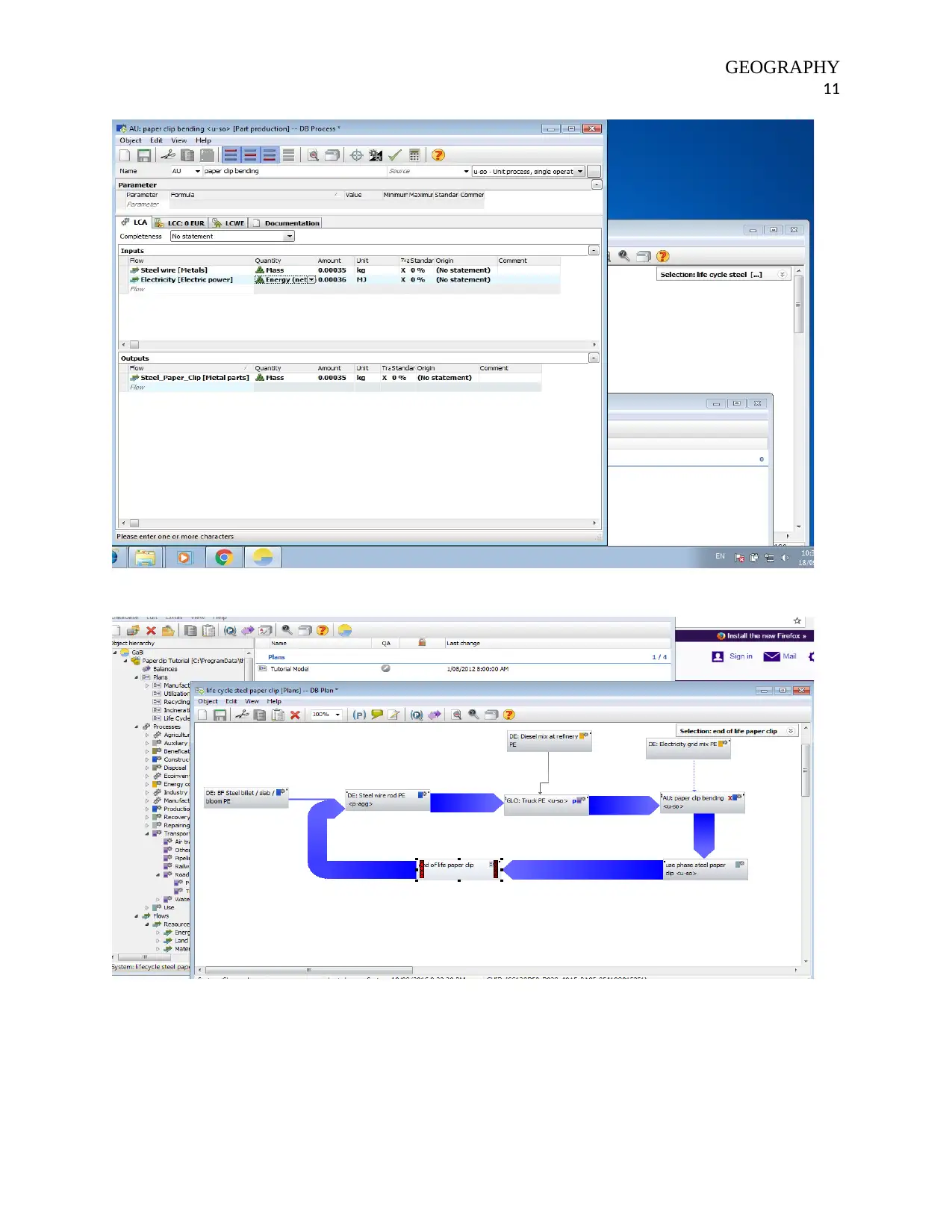
GEOGRAPHY
11
11
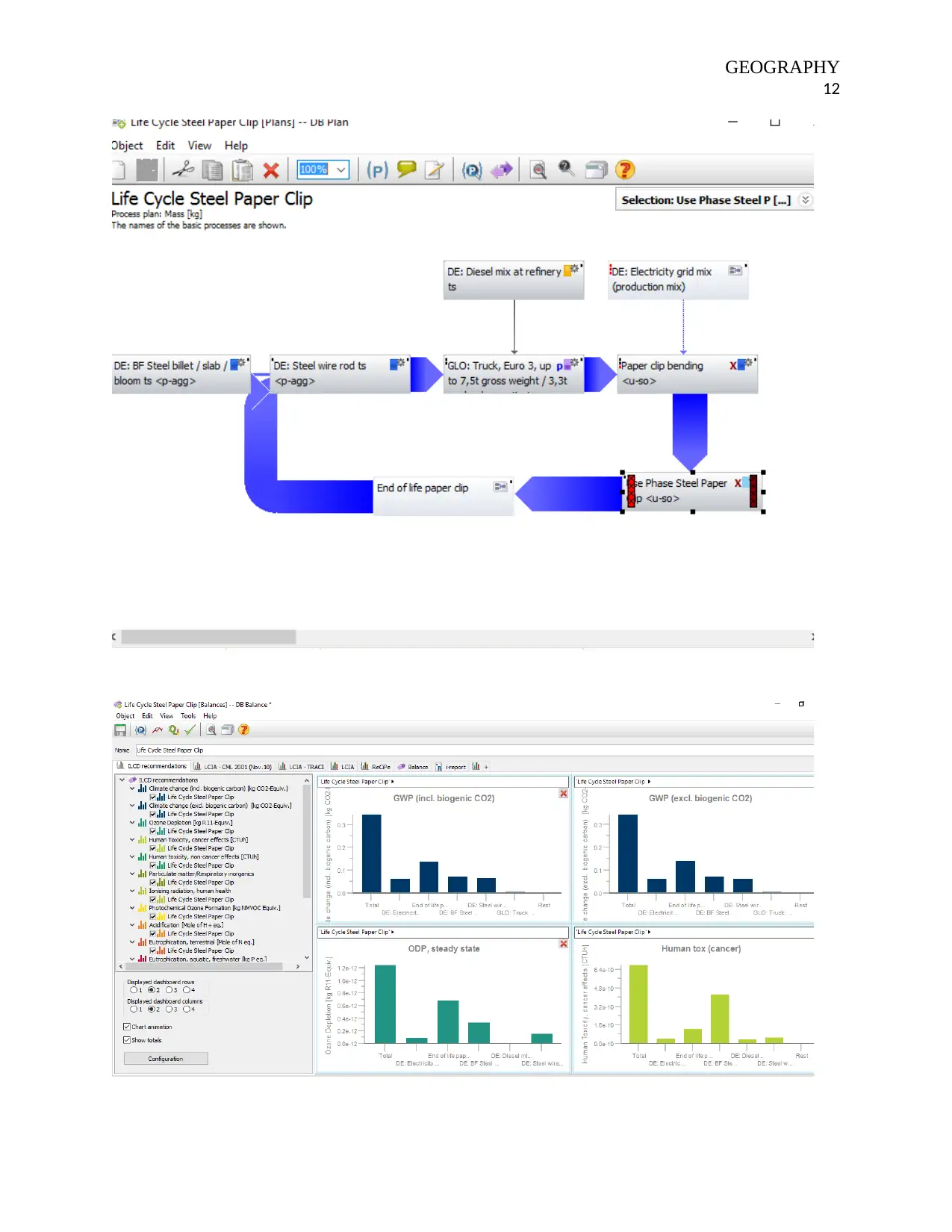
GEOGRAPHY
12
12
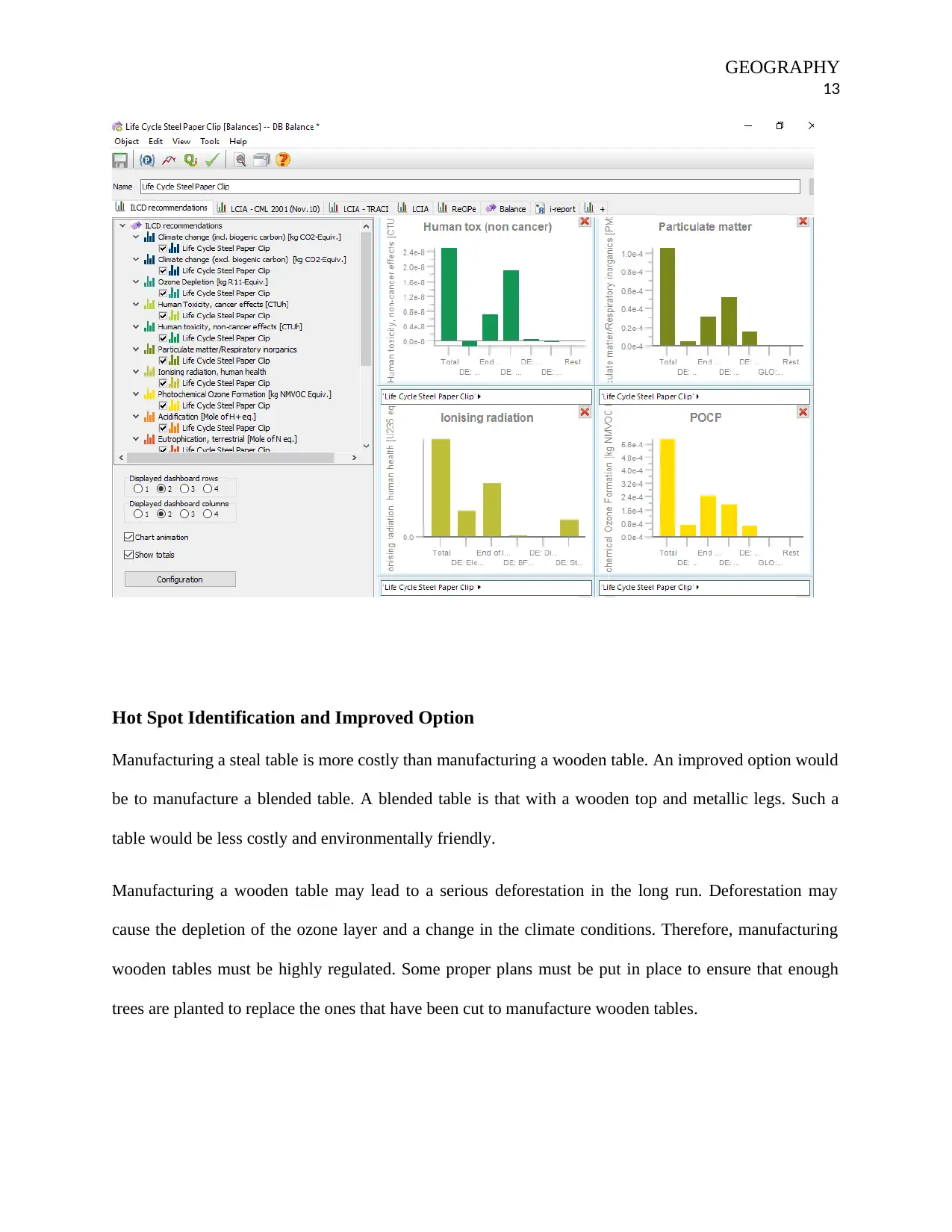
GEOGRAPHY
13
Hot Spot Identification and Improved Option
Manufacturing a steal table is more costly than manufacturing a wooden table. An improved option would
be to manufacture a blended table. A blended table is that with a wooden top and metallic legs. Such a
table would be less costly and environmentally friendly.
Manufacturing a wooden table may lead to a serious deforestation in the long run. Deforestation may
cause the depletion of the ozone layer and a change in the climate conditions. Therefore, manufacturing
wooden tables must be highly regulated. Some proper plans must be put in place to ensure that enough
trees are planted to replace the ones that have been cut to manufacture wooden tables.
13
Hot Spot Identification and Improved Option
Manufacturing a steal table is more costly than manufacturing a wooden table. An improved option would
be to manufacture a blended table. A blended table is that with a wooden top and metallic legs. Such a
table would be less costly and environmentally friendly.
Manufacturing a wooden table may lead to a serious deforestation in the long run. Deforestation may
cause the depletion of the ozone layer and a change in the climate conditions. Therefore, manufacturing
wooden tables must be highly regulated. Some proper plans must be put in place to ensure that enough
trees are planted to replace the ones that have been cut to manufacture wooden tables.
Paraphrase This Document
Need a fresh take? Get an instant paraphrase of this document with our AI Paraphraser
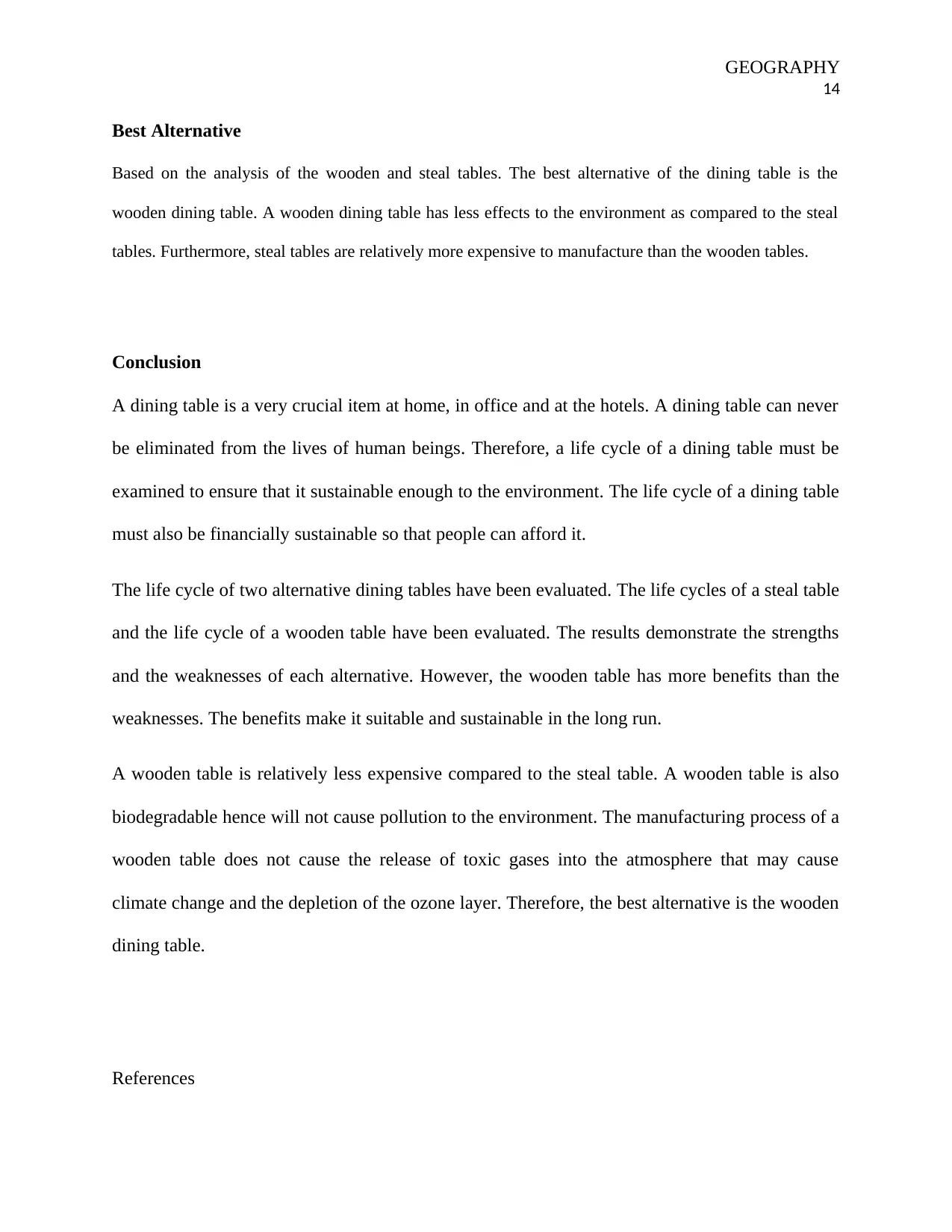
GEOGRAPHY
14
Best Alternative
Based on the analysis of the wooden and steal tables. The best alternative of the dining table is the
wooden dining table. A wooden dining table has less effects to the environment as compared to the steal
tables. Furthermore, steal tables are relatively more expensive to manufacture than the wooden tables.
Conclusion
A dining table is a very crucial item at home, in office and at the hotels. A dining table can never
be eliminated from the lives of human beings. Therefore, a life cycle of a dining table must be
examined to ensure that it sustainable enough to the environment. The life cycle of a dining table
must also be financially sustainable so that people can afford it.
The life cycle of two alternative dining tables have been evaluated. The life cycles of a steal table
and the life cycle of a wooden table have been evaluated. The results demonstrate the strengths
and the weaknesses of each alternative. However, the wooden table has more benefits than the
weaknesses. The benefits make it suitable and sustainable in the long run.
A wooden table is relatively less expensive compared to the steal table. A wooden table is also
biodegradable hence will not cause pollution to the environment. The manufacturing process of a
wooden table does not cause the release of toxic gases into the atmosphere that may cause
climate change and the depletion of the ozone layer. Therefore, the best alternative is the wooden
dining table.
References
14
Best Alternative
Based on the analysis of the wooden and steal tables. The best alternative of the dining table is the
wooden dining table. A wooden dining table has less effects to the environment as compared to the steal
tables. Furthermore, steal tables are relatively more expensive to manufacture than the wooden tables.
Conclusion
A dining table is a very crucial item at home, in office and at the hotels. A dining table can never
be eliminated from the lives of human beings. Therefore, a life cycle of a dining table must be
examined to ensure that it sustainable enough to the environment. The life cycle of a dining table
must also be financially sustainable so that people can afford it.
The life cycle of two alternative dining tables have been evaluated. The life cycles of a steal table
and the life cycle of a wooden table have been evaluated. The results demonstrate the strengths
and the weaknesses of each alternative. However, the wooden table has more benefits than the
weaknesses. The benefits make it suitable and sustainable in the long run.
A wooden table is relatively less expensive compared to the steal table. A wooden table is also
biodegradable hence will not cause pollution to the environment. The manufacturing process of a
wooden table does not cause the release of toxic gases into the atmosphere that may cause
climate change and the depletion of the ozone layer. Therefore, the best alternative is the wooden
dining table.
References
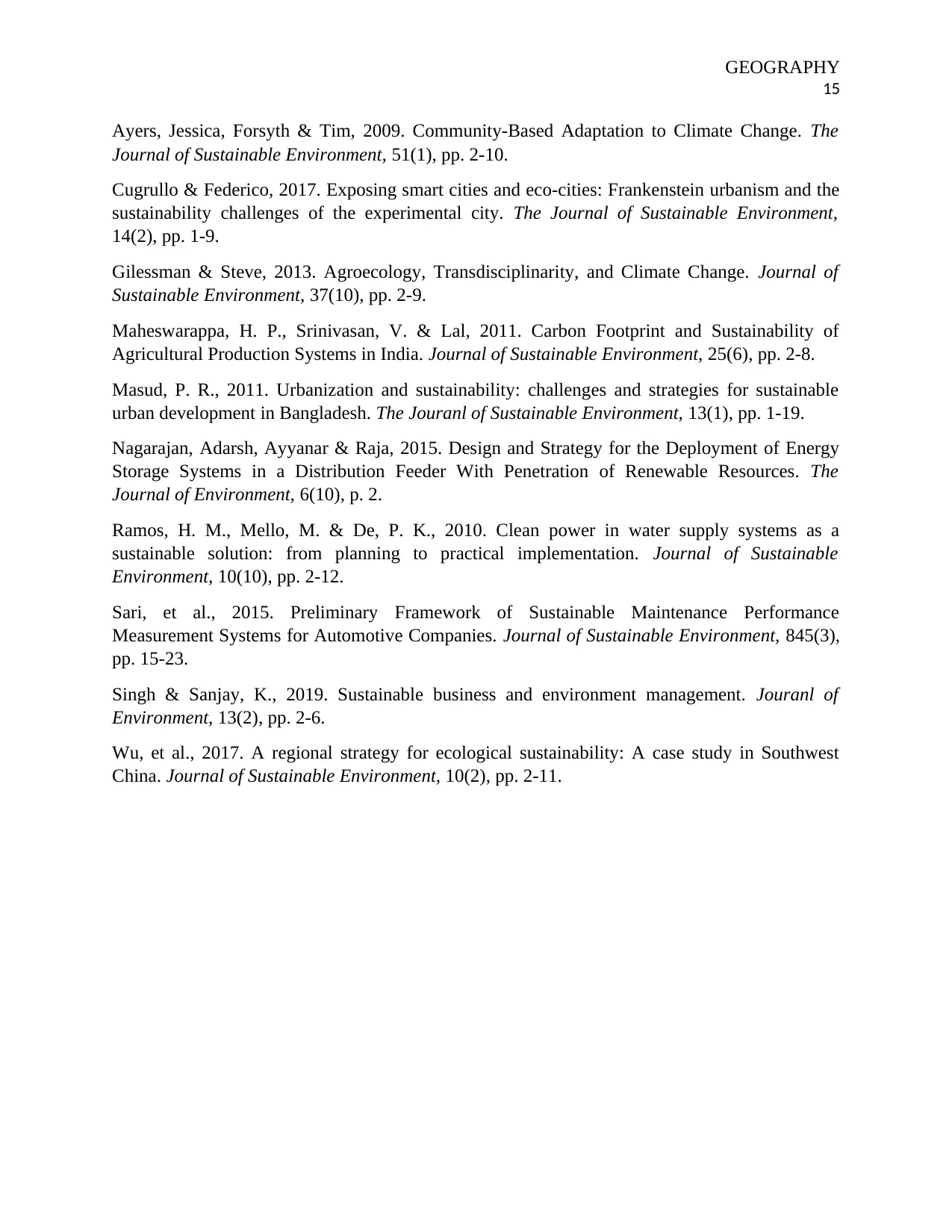
GEOGRAPHY
15
Ayers, Jessica, Forsyth & Tim, 2009. Community-Based Adaptation to Climate Change. The
Journal of Sustainable Environment, 51(1), pp. 2-10.
Cugrullo & Federico, 2017. Exposing smart cities and eco-cities: Frankenstein urbanism and the
sustainability challenges of the experimental city. The Journal of Sustainable Environment,
14(2), pp. 1-9.
Gilessman & Steve, 2013. Agroecology, Transdisciplinarity, and Climate Change. Journal of
Sustainable Environment, 37(10), pp. 2-9.
Maheswarappa, H. P., Srinivasan, V. & Lal, 2011. Carbon Footprint and Sustainability of
Agricultural Production Systems in India. Journal of Sustainable Environment, 25(6), pp. 2-8.
Masud, P. R., 2011. Urbanization and sustainability: challenges and strategies for sustainable
urban development in Bangladesh. The Jouranl of Sustainable Environment, 13(1), pp. 1-19.
Nagarajan, Adarsh, Ayyanar & Raja, 2015. Design and Strategy for the Deployment of Energy
Storage Systems in a Distribution Feeder With Penetration of Renewable Resources. The
Journal of Environment, 6(10), p. 2.
Ramos, H. M., Mello, M. & De, P. K., 2010. Clean power in water supply systems as a
sustainable solution: from planning to practical implementation. Journal of Sustainable
Environment, 10(10), pp. 2-12.
Sari, et al., 2015. Preliminary Framework of Sustainable Maintenance Performance
Measurement Systems for Automotive Companies. Journal of Sustainable Environment, 845(3),
pp. 15-23.
Singh & Sanjay, K., 2019. Sustainable business and environment management. Jouranl of
Environment, 13(2), pp. 2-6.
Wu, et al., 2017. A regional strategy for ecological sustainability: A case study in Southwest
China. Journal of Sustainable Environment, 10(2), pp. 2-11.
15
Ayers, Jessica, Forsyth & Tim, 2009. Community-Based Adaptation to Climate Change. The
Journal of Sustainable Environment, 51(1), pp. 2-10.
Cugrullo & Federico, 2017. Exposing smart cities and eco-cities: Frankenstein urbanism and the
sustainability challenges of the experimental city. The Journal of Sustainable Environment,
14(2), pp. 1-9.
Gilessman & Steve, 2013. Agroecology, Transdisciplinarity, and Climate Change. Journal of
Sustainable Environment, 37(10), pp. 2-9.
Maheswarappa, H. P., Srinivasan, V. & Lal, 2011. Carbon Footprint and Sustainability of
Agricultural Production Systems in India. Journal of Sustainable Environment, 25(6), pp. 2-8.
Masud, P. R., 2011. Urbanization and sustainability: challenges and strategies for sustainable
urban development in Bangladesh. The Jouranl of Sustainable Environment, 13(1), pp. 1-19.
Nagarajan, Adarsh, Ayyanar & Raja, 2015. Design and Strategy for the Deployment of Energy
Storage Systems in a Distribution Feeder With Penetration of Renewable Resources. The
Journal of Environment, 6(10), p. 2.
Ramos, H. M., Mello, M. & De, P. K., 2010. Clean power in water supply systems as a
sustainable solution: from planning to practical implementation. Journal of Sustainable
Environment, 10(10), pp. 2-12.
Sari, et al., 2015. Preliminary Framework of Sustainable Maintenance Performance
Measurement Systems for Automotive Companies. Journal of Sustainable Environment, 845(3),
pp. 15-23.
Singh & Sanjay, K., 2019. Sustainable business and environment management. Jouranl of
Environment, 13(2), pp. 2-6.
Wu, et al., 2017. A regional strategy for ecological sustainability: A case study in Southwest
China. Journal of Sustainable Environment, 10(2), pp. 2-11.
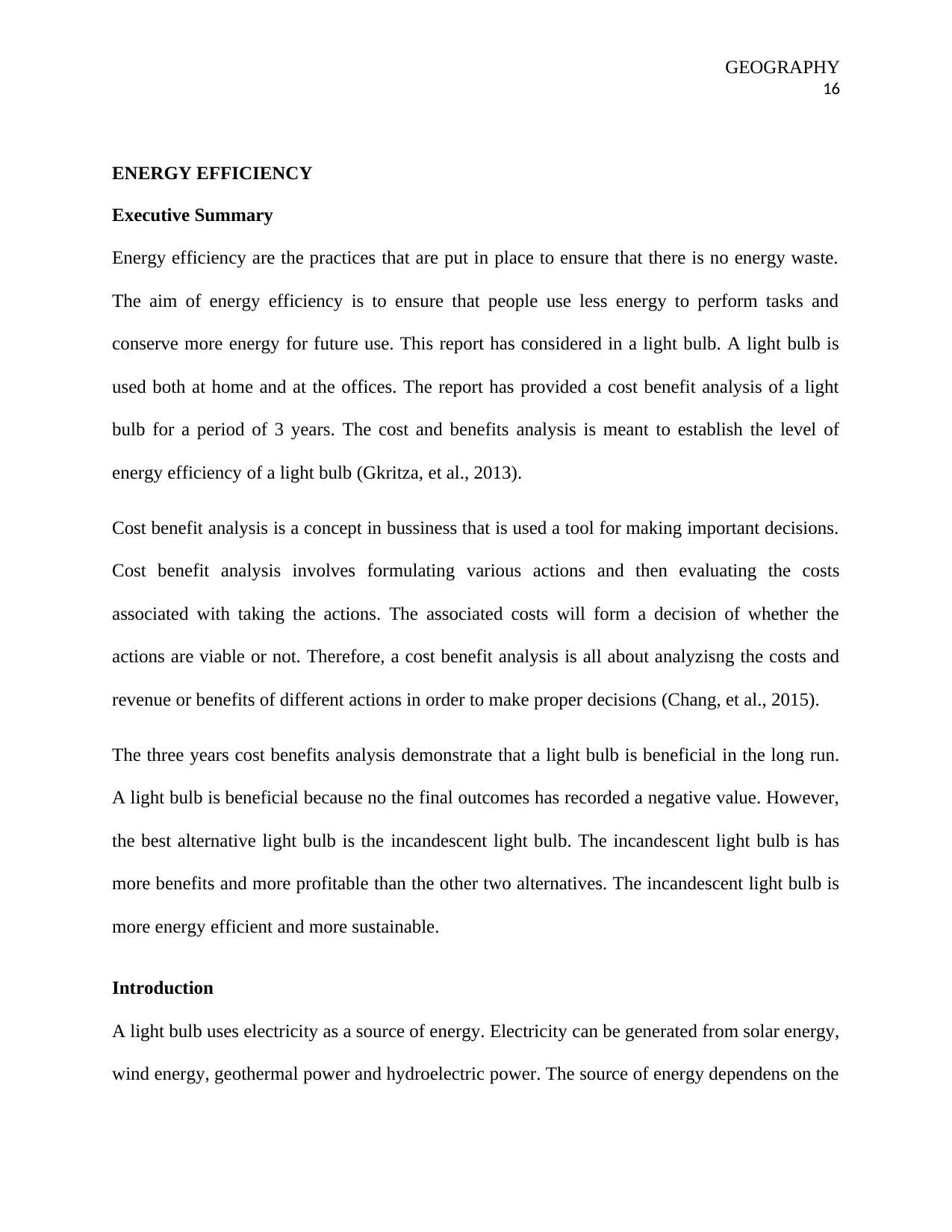
GEOGRAPHY
16
ENERGY EFFICIENCY
Executive Summary
Energy efficiency are the practices that are put in place to ensure that there is no energy waste.
The aim of energy efficiency is to ensure that people use less energy to perform tasks and
conserve more energy for future use. This report has considered in a light bulb. A light bulb is
used both at home and at the offices. The report has provided a cost benefit analysis of a light
bulb for a period of 3 years. The cost and benefits analysis is meant to establish the level of
energy efficiency of a light bulb (Gkritza, et al., 2013).
Cost benefit analysis is a concept in bussiness that is used a tool for making important decisions.
Cost benefit analysis involves formulating various actions and then evaluating the costs
associated with taking the actions. The associated costs will form a decision of whether the
actions are viable or not. Therefore, a cost benefit analysis is all about analyzisng the costs and
revenue or benefits of different actions in order to make proper decisions (Chang, et al., 2015).
The three years cost benefits analysis demonstrate that a light bulb is beneficial in the long run.
A light bulb is beneficial because no the final outcomes has recorded a negative value. However,
the best alternative light bulb is the incandescent light bulb. The incandescent light bulb is has
more benefits and more profitable than the other two alternatives. The incandescent light bulb is
more energy efficient and more sustainable.
Introduction
A light bulb uses electricity as a source of energy. Electricity can be generated from solar energy,
wind energy, geothermal power and hydroelectric power. The source of energy dependens on the
16
ENERGY EFFICIENCY
Executive Summary
Energy efficiency are the practices that are put in place to ensure that there is no energy waste.
The aim of energy efficiency is to ensure that people use less energy to perform tasks and
conserve more energy for future use. This report has considered in a light bulb. A light bulb is
used both at home and at the offices. The report has provided a cost benefit analysis of a light
bulb for a period of 3 years. The cost and benefits analysis is meant to establish the level of
energy efficiency of a light bulb (Gkritza, et al., 2013).
Cost benefit analysis is a concept in bussiness that is used a tool for making important decisions.
Cost benefit analysis involves formulating various actions and then evaluating the costs
associated with taking the actions. The associated costs will form a decision of whether the
actions are viable or not. Therefore, a cost benefit analysis is all about analyzisng the costs and
revenue or benefits of different actions in order to make proper decisions (Chang, et al., 2015).
The three years cost benefits analysis demonstrate that a light bulb is beneficial in the long run.
A light bulb is beneficial because no the final outcomes has recorded a negative value. However,
the best alternative light bulb is the incandescent light bulb. The incandescent light bulb is has
more benefits and more profitable than the other two alternatives. The incandescent light bulb is
more energy efficient and more sustainable.
Introduction
A light bulb uses electricity as a source of energy. Electricity can be generated from solar energy,
wind energy, geothermal power and hydroelectric power. The source of energy dependens on the
Secure Best Marks with AI Grader
Need help grading? Try our AI Grader for instant feedback on your assignments.

GEOGRAPHY
17
availability and the costs associated. Since a light bulb is used on a daily basis, it is important to
investigate its level of energy efficiency. Similarly, it is important to investigate the cost benefit
of an electric bulb for a given period of time (3 years in our case) (Gkritza, et al., 2013).
Cost benefit analysis of a Water Dispenser
Cost benefit analysis is a business concept that is used a tool for making important decisions.
Cost benefit analysis involves formulating various actions and then evaluating the costs
associated with taking the actions. The associated costs will form a decision of whether the
actions are viable or not. Therefore, a cost benefit analysis is all about analysisng the costs and
revenue or benefits of different actions in order to make proper decistions. Cost benefits analysis
requires certan relevant information in order to be successful (Fernando, et al., 2017).
The relevant information are: The energy consumption rate of a light bulb, the various
alternatives to a light bulb, the energy efficiency of a light bulb and the cost of purchasing and
mainting a light bulb. The relevant information are summarized in the cost benefits analysis table
(Froehe, et al., 2012).
Organization that promotes energy efficiency in Australia include: Australian & New Zealand
Solar Energy Society, Clean Energy Council, Renewable Energy Society, Alternative
Technology.
.Assocaition and Fuel Cell Institute of Australian Pty Limited. I selected Port Augusta
(32°29′33″S 137°45′57″E) which is a town located in the south of Australia.
The consumption of energy in a water dispenser can be reduced by maintaining effective and
proper use of the device. Some of the common practices include: Using the device only it is
necessary and switching it off when unnecessary, always switching it off when one is way from
17
availability and the costs associated. Since a light bulb is used on a daily basis, it is important to
investigate its level of energy efficiency. Similarly, it is important to investigate the cost benefit
of an electric bulb for a given period of time (3 years in our case) (Gkritza, et al., 2013).
Cost benefit analysis of a Water Dispenser
Cost benefit analysis is a business concept that is used a tool for making important decisions.
Cost benefit analysis involves formulating various actions and then evaluating the costs
associated with taking the actions. The associated costs will form a decision of whether the
actions are viable or not. Therefore, a cost benefit analysis is all about analysisng the costs and
revenue or benefits of different actions in order to make proper decistions. Cost benefits analysis
requires certan relevant information in order to be successful (Fernando, et al., 2017).
The relevant information are: The energy consumption rate of a light bulb, the various
alternatives to a light bulb, the energy efficiency of a light bulb and the cost of purchasing and
mainting a light bulb. The relevant information are summarized in the cost benefits analysis table
(Froehe, et al., 2012).
Organization that promotes energy efficiency in Australia include: Australian & New Zealand
Solar Energy Society, Clean Energy Council, Renewable Energy Society, Alternative
Technology.
.Assocaition and Fuel Cell Institute of Australian Pty Limited. I selected Port Augusta
(32°29′33″S 137°45′57″E) which is a town located in the south of Australia.
The consumption of energy in a water dispenser can be reduced by maintaining effective and
proper use of the device. Some of the common practices include: Using the device only it is
necessary and switching it off when unnecessary, always switching it off when one is way from
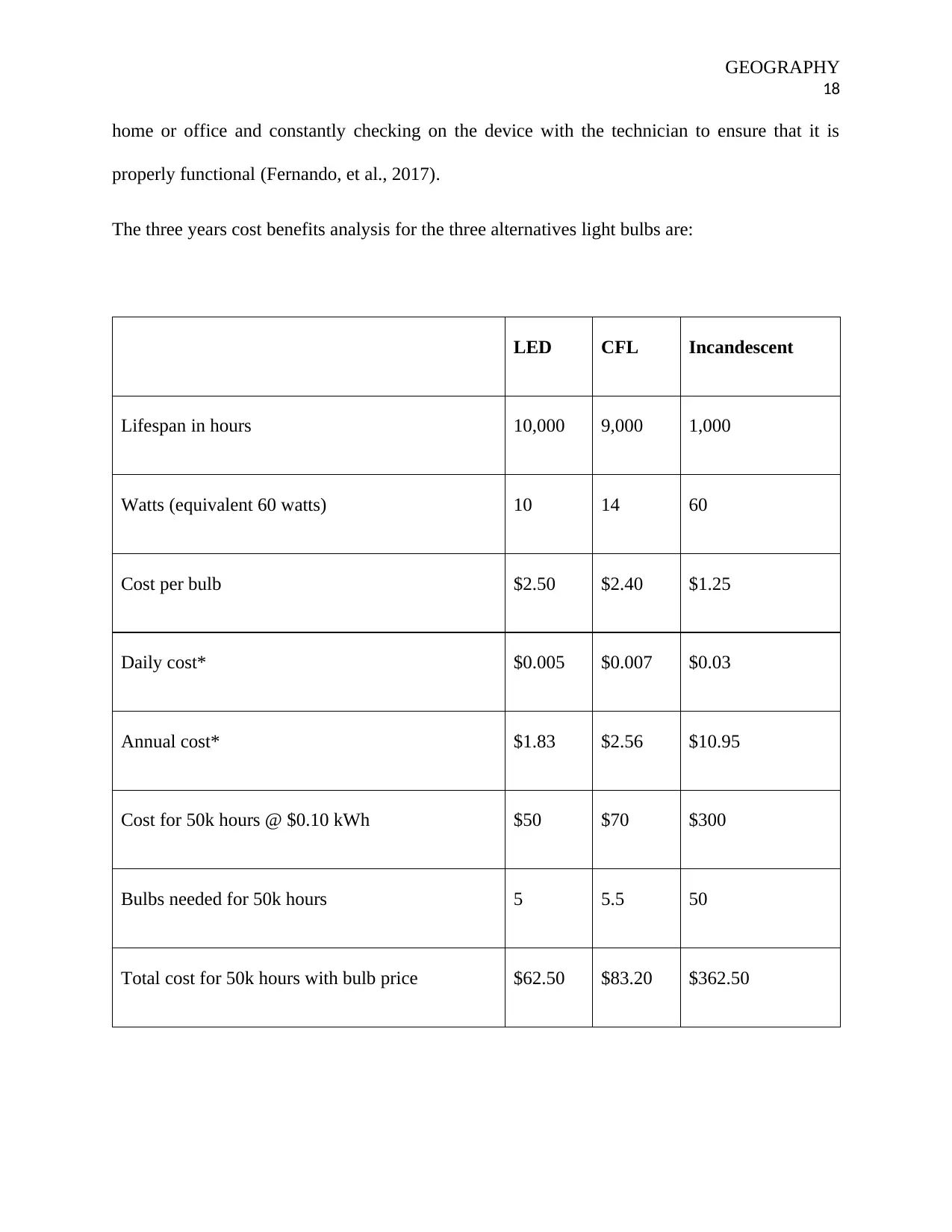
GEOGRAPHY
18
home or office and constantly checking on the device with the technician to ensure that it is
properly functional (Fernando, et al., 2017).
The three years cost benefits analysis for the three alternatives light bulbs are:
LED CFL Incandescent
Lifespan in hours 10,000 9,000 1,000
Watts (equivalent 60 watts) 10 14 60
Cost per bulb $2.50 $2.40 $1.25
Daily cost* $0.005 $0.007 $0.03
Annual cost* $1.83 $2.56 $10.95
Cost for 50k hours @ $0.10 kWh $50 $70 $300
Bulbs needed for 50k hours 5 5.5 50
Total cost for 50k hours with bulb price $62.50 $83.20 $362.50
18
home or office and constantly checking on the device with the technician to ensure that it is
properly functional (Fernando, et al., 2017).
The three years cost benefits analysis for the three alternatives light bulbs are:
LED CFL Incandescent
Lifespan in hours 10,000 9,000 1,000
Watts (equivalent 60 watts) 10 14 60
Cost per bulb $2.50 $2.40 $1.25
Daily cost* $0.005 $0.007 $0.03
Annual cost* $1.83 $2.56 $10.95
Cost for 50k hours @ $0.10 kWh $50 $70 $300
Bulbs needed for 50k hours 5 5.5 50
Total cost for 50k hours with bulb price $62.50 $83.20 $362.50
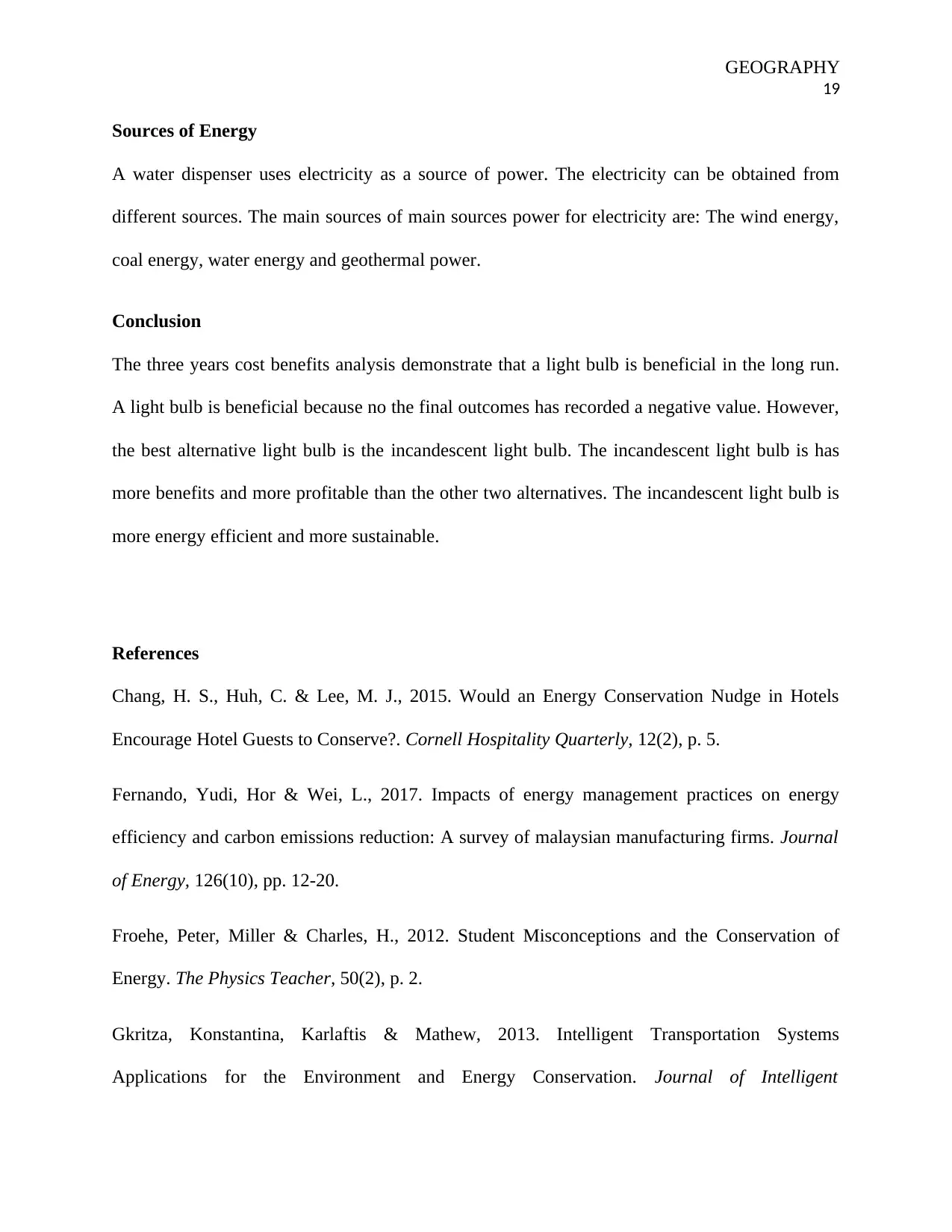
GEOGRAPHY
19
Sources of Energy
A water dispenser uses electricity as a source of power. The electricity can be obtained from
different sources. The main sources of main sources power for electricity are: The wind energy,
coal energy, water energy and geothermal power.
Conclusion
The three years cost benefits analysis demonstrate that a light bulb is beneficial in the long run.
A light bulb is beneficial because no the final outcomes has recorded a negative value. However,
the best alternative light bulb is the incandescent light bulb. The incandescent light bulb is has
more benefits and more profitable than the other two alternatives. The incandescent light bulb is
more energy efficient and more sustainable.
References
Chang, H. S., Huh, C. & Lee, M. J., 2015. Would an Energy Conservation Nudge in Hotels
Encourage Hotel Guests to Conserve?. Cornell Hospitality Quarterly, 12(2), p. 5.
Fernando, Yudi, Hor & Wei, L., 2017. Impacts of energy management practices on energy
efficiency and carbon emissions reduction: A survey of malaysian manufacturing firms. Journal
of Energy, 126(10), pp. 12-20.
Froehe, Peter, Miller & Charles, H., 2012. Student Misconceptions and the Conservation of
Energy. The Physics Teacher, 50(2), p. 2.
Gkritza, Konstantina, Karlaftis & Mathew, 2013. Intelligent Transportation Systems
Applications for the Environment and Energy Conservation. Journal of Intelligent
19
Sources of Energy
A water dispenser uses electricity as a source of power. The electricity can be obtained from
different sources. The main sources of main sources power for electricity are: The wind energy,
coal energy, water energy and geothermal power.
Conclusion
The three years cost benefits analysis demonstrate that a light bulb is beneficial in the long run.
A light bulb is beneficial because no the final outcomes has recorded a negative value. However,
the best alternative light bulb is the incandescent light bulb. The incandescent light bulb is has
more benefits and more profitable than the other two alternatives. The incandescent light bulb is
more energy efficient and more sustainable.
References
Chang, H. S., Huh, C. & Lee, M. J., 2015. Would an Energy Conservation Nudge in Hotels
Encourage Hotel Guests to Conserve?. Cornell Hospitality Quarterly, 12(2), p. 5.
Fernando, Yudi, Hor & Wei, L., 2017. Impacts of energy management practices on energy
efficiency and carbon emissions reduction: A survey of malaysian manufacturing firms. Journal
of Energy, 126(10), pp. 12-20.
Froehe, Peter, Miller & Charles, H., 2012. Student Misconceptions and the Conservation of
Energy. The Physics Teacher, 50(2), p. 2.
Gkritza, Konstantina, Karlaftis & Mathew, 2013. Intelligent Transportation Systems
Applications for the Environment and Energy Conservation. Journal of Intelligent
Paraphrase This Document
Need a fresh take? Get an instant paraphrase of this document with our AI Paraphraser
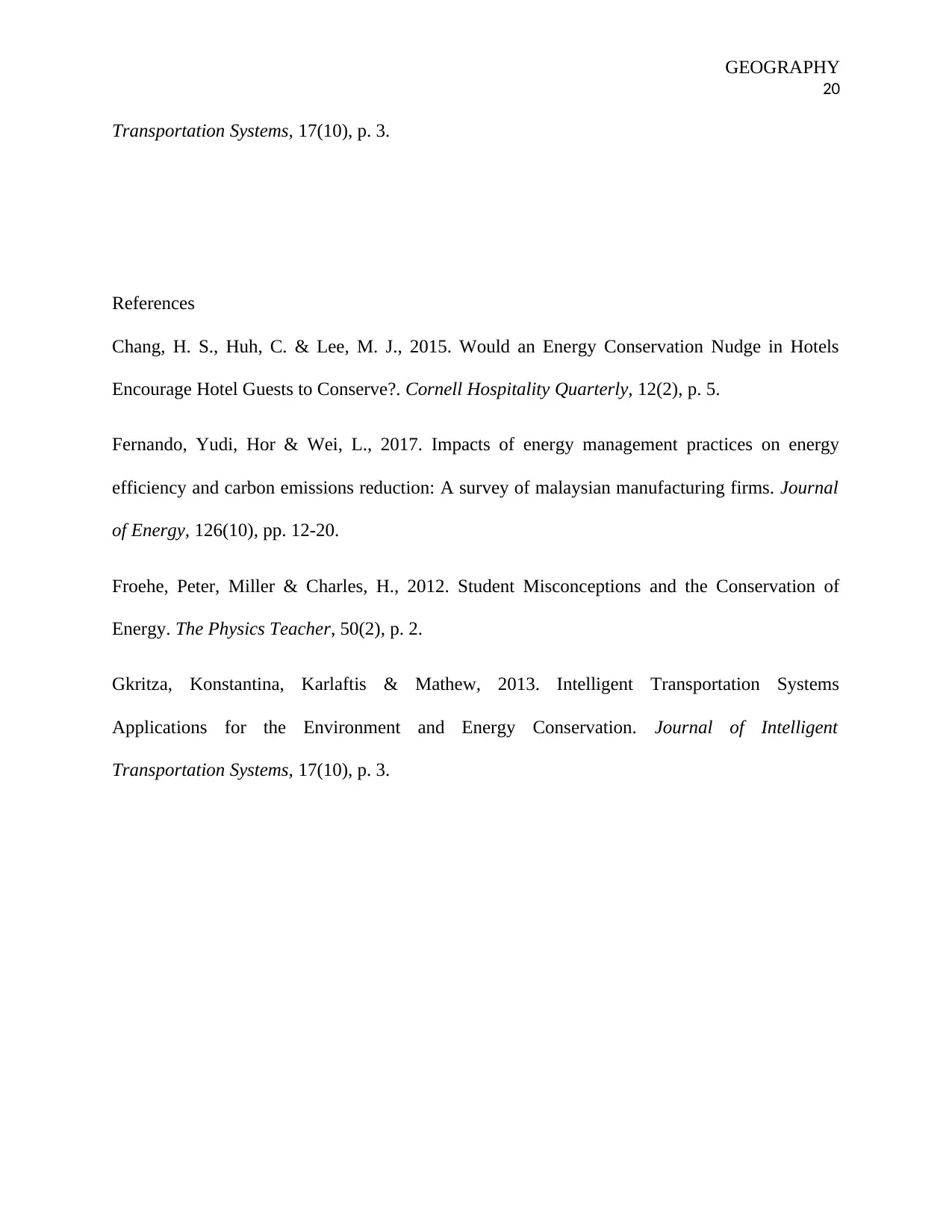
GEOGRAPHY
20
Transportation Systems, 17(10), p. 3.
References
Chang, H. S., Huh, C. & Lee, M. J., 2015. Would an Energy Conservation Nudge in Hotels
Encourage Hotel Guests to Conserve?. Cornell Hospitality Quarterly, 12(2), p. 5.
Fernando, Yudi, Hor & Wei, L., 2017. Impacts of energy management practices on energy
efficiency and carbon emissions reduction: A survey of malaysian manufacturing firms. Journal
of Energy, 126(10), pp. 12-20.
Froehe, Peter, Miller & Charles, H., 2012. Student Misconceptions and the Conservation of
Energy. The Physics Teacher, 50(2), p. 2.
Gkritza, Konstantina, Karlaftis & Mathew, 2013. Intelligent Transportation Systems
Applications for the Environment and Energy Conservation. Journal of Intelligent
Transportation Systems, 17(10), p. 3.
20
Transportation Systems, 17(10), p. 3.
References
Chang, H. S., Huh, C. & Lee, M. J., 2015. Would an Energy Conservation Nudge in Hotels
Encourage Hotel Guests to Conserve?. Cornell Hospitality Quarterly, 12(2), p. 5.
Fernando, Yudi, Hor & Wei, L., 2017. Impacts of energy management practices on energy
efficiency and carbon emissions reduction: A survey of malaysian manufacturing firms. Journal
of Energy, 126(10), pp. 12-20.
Froehe, Peter, Miller & Charles, H., 2012. Student Misconceptions and the Conservation of
Energy. The Physics Teacher, 50(2), p. 2.
Gkritza, Konstantina, Karlaftis & Mathew, 2013. Intelligent Transportation Systems
Applications for the Environment and Energy Conservation. Journal of Intelligent
Transportation Systems, 17(10), p. 3.

GEOGRAPHY
21
21
1 out of 21
Related Documents
Your All-in-One AI-Powered Toolkit for Academic Success.
+13062052269
info@desklib.com
Available 24*7 on WhatsApp / Email
![[object Object]](/_next/static/media/star-bottom.7253800d.svg)
Unlock your academic potential
© 2024 | Zucol Services PVT LTD | All rights reserved.





